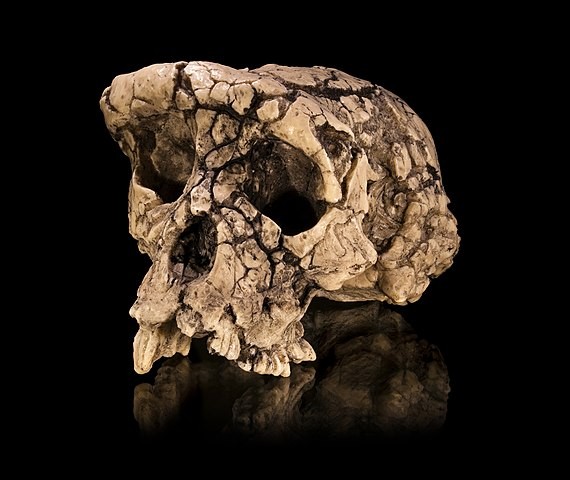Sahelanthropus tchadensis is an extinct hominin species that lived approximately 7 million years ago. It is a crucial part of the early hominin fossil record and has contributed to our understanding of the evolutionary history of the human lineage. Here are key discoveries associated with Sahelanthropus tchadensis:
Discovery and Location:
- Discovery Date: The fossils of Sahelanthropus tchadensis were discovered in 2001 during paleontological expeditions in Chad, Central Africa.

Toumaï - Location: The fossils were found in the Toros-Menalla region, near the village of Toros-Menalla in the Djurab Desert. The region has since become known for its significance in early hominin fossil discoveries.
Fossil Finds:
- Type Specimen (TM 266-01-060-1): The holotype specimen of Sahelanthropus tchadensis is a nearly complete cranium designated as TM 266-01-060-1. This fossil is the primary basis for the species description.
- Additional Cranial and Dental Fragments: Alongside the holotype cranium, other cranial and dental fragments from multiple individuals were discovered at the same site.
Morphological Features:
- Cranial Morphology: Sahelanthropus tchadensis displays a mix of ape-like and hominin-like cranial features. The foramen magnum, the opening at the base of the skull for the spinal cord, is positioned more forward, suggesting a more upright posture compared to non-hominin primates.
- Small Brain Size: The brain size of Sahelanthropus tchadensis is estimated to be small, more akin to chimpanzees than later hominins.
- Dental Characteristics: The canine teeth are smaller and less projecting than those of chimpanzees, showing some similarities to later hominins. The molars, however, have a thick enamel, which is a more primitive feature.
Implications for Bipedalism:
- Position of the Foramen Magnum: The forward position of the foramen magnum in Sahelanthropus tchadensis suggests that it could have walked upright to some degree. This is a key characteristic associated with hominins.
- Bipedal Adaptations: The anatomical features of the cranium and dentition, combined with the position of the foramen magnum, have led researchers to infer that Sahelanthropus tchadensis may have exhibited some adaptations to bipedalism.
Phylogenetic Significance:
- Hominin or Hominoid: The classification of Sahelanthropus tchadensis as a hominin or a hominoid is a subject of debate among paleoanthropologists. Some researchers consider it a potential basal hominin, while others emphasize its more ape-like features.
- Divergence from Common Ancestor: Sahelanthropus tchadensis is thought to represent a species that lived close to the divergence point of the hominid lineage from the common ancestor shared with chimpanzees.
Environmental Context:
- Paleoenvironment: The discovery site in Chad was once part of a wooded environment with rivers and lakes. Understanding the paleoenvironment helps researchers reconstruct the habitat and ecological context in which Sahelanthropus tchadensis lived.
Ongoing Research:
- Continued Analysis: Ongoing research involves further analysis of the existing fossils and, potentially, the discovery of new fossils. Advances in technology, such as imaging techniques and dating methods, contribute to refining our understanding of Sahelanthropus tchadensis.
- Comparative Studies: Comparative studies with other early hominins and hominoids contribute to our understanding of the evolutionary relationships and adaptations within the hominid lineage.
Sahelanthropus tchadensis represents a key milestone in the study of early hominin evolution. While its classification and place in the hominid family tree are still subjects of debate, its discovery provides valuable insights into the early stages of bipedalism and the diverse forms that hominins may have taken during the Miocene epoch. Ongoing research continues to shed light on the significance of Sahelanthropus tchadensis in the broader context of human evolutionary history.











